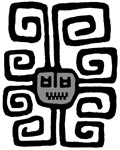Centre for Textile Research
Date of this Version
6-2020
Document Type
Article
Citation
DOI: 10.32873/unl.dc.zea.1210
Published in PreColumbian Textile Conference VIII / Jornadas de Textiles PreColombinos VIII, ed. Lena Bjerregaard and Ann Peters (Lincoln, NE: Zea Books, 2020). https://digitalcommons.unl.edu/zeabook/
Abstract
En el hallazgo de Llullaillaco los motivos de tocapu y cumbi se reiteran en importantes textiles que visten a los niños ofrendados y en otros en forma de miniatura vistiendo a las estatuillas que conforman el ajuar. Tanto las miniaturas antropomorfas de metal (oro y plata) como las de mullu (spondylus) están vestidas con uncu (túnica), yacolla (manto) y llautu (o vincha) y llevan una bolsa o chuspa con los mismos diseños que las prendas que visten los niños. Nuestra comprensión del significado de tocapu se basa en cómo ha sido descrito por los cronistas, asociado a veces íntimamente con el textil y otras a la narrativa, aunque no conozcamos aún un sistema que nos permita descifrarlo. Ha sido utilizado en forma radicalmente diferente: política, cultural y religiosamente. Se identifica por tener a veces un patrón repetitivo y otras no, con formas abstractas, compuestos por figuras geométricas y líneas organizadas que representan un sentido. Es transhistórico, podemos hallarlo hoy en diferentes regiones vinculado a la arquitectura, los símbolos rituales, al Inca, y en siglos posteriores influenciando vestimentas y mantos ricamente ornamentados (por ejemplo, en el período colonial).
In the Llullaillaco contexts, the tocapu and cumbi designs are repeated in significant textiles worn by the sacrificed children and on the miniatures worn by the figurines that make up the offerings. Both the anthropomorphic metal miniatures (in gold and silver) and those of mullu (spondylus) are dressed with an uncu (tunic), yacolla (cloak) and llautu (headband). They carry a bag or chuspa with the same patterns as the clothes the children are wearing. Our understating of the meaning of tocapu is based on the descriptions of chroniclers. These descriptions are sometimes intimately linked to the idea of textiles, and at other times to the narrative of the designs, although we do not know yet a system that allows us to decipher its real meaning. Tocapu has been used radically differently in political, cultural and religious fields. They are defined by having a repetitive pattern sometimes, though not repetitive at other times, with abstract shapes composed of geometric figures and organized lines that represent a meaning. Tocapu is transhistorical, we can find it today in different regions linked to architecture, ritual symbols, to the Inca, and in later centuries influencing richly ornamental clothes and cloaks (for example, in the colonial period).
Dans les contextes Llullaillaco, les motifs tocapu et cumbi se répètent dans les textiles importants portés par les enfants sacrifiés ainsi que dans les éléments miniatures que vêtent les statuettes qui composent l’offrande. Tant les miniatures anthropomorphes en métal (or et argent) que celles en mullu (Spondylus) sont revêtues d’un uncu (tunique), d’une yacolla (manteau) et d’un llauto (bandeau) et ont un sac ou chuspa avec les mêmes motifs que les vêtements que portent les enfants. Notre compréhension de la signification des tocapu repose sur la façon dont ils sont décrits par les chroniqueurs, parfois en association étroite avec les textiles, et d’autres fois selon l’aspect narratif des figures, bien que nous ne connaissions pas encore de système permettant de véritablement déchiffrer leur sens. Les tocapu ont été utilisés de manière totalement différente : politique, culturelle ou religieuse. Ils s’identifient par la présence d’un modèle répétitif occasionnel, comprenant des formes abstraites, composées par des figures géométriques et des lignes organisées évocatrices d’un sens précis. Les tocapus sont transhistoriques, nous pouvons les trouver de nos jours dans différentes régions liées à l’architecture, aux symboles rituels, au pouvoir, à l’Inca, et dans les siècles suivants influençant les vêtements et les tuniques richement décorés (par exemple, à l’époque coloniale).
Included in
Art and Materials Conservation Commons, Fiber, Textile, and Weaving Arts Commons, Indigenous Studies Commons, Latin American Languages and Societies Commons, Museum Studies Commons, Other History of Art, Architecture, and Archaeology Commons


Comments
Copyright 2020 Beatriz Carbonell